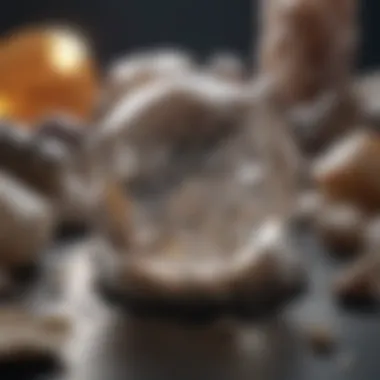Unveiling the Diverse Applications of Quartz: A Journey into Its Remarkable Versatility


Rock and Fossil Identification
Quartz is a mineral with distinctive characteristics that make it stand out in the world of rocks and fossils. When identifying quartz, look for its hexagonal crystal structure, glassy luster, and hardness that can scratch glass. Tools such as a geologist's hammer, magnifying glass, and streak plate can aid in distinguishing quartz from other minerals in the field.
Utilization in Technology and Industry
Quartz's exceptional properties have made it indispensable in various technological and industrial applications. In the electronics industry, quartz is used in oscillators, resonators, and microchips due to its ability to generate precise electrical signals. Its thermal and chemical stability also make it ideal for manufacturing glass, ceramics, and abrasives, contributing significantly to advancements in modern technology.
Spiritual and Wellness Applications
Beyond its industrial uses, quartz holds spiritual significance and therapeutic properties. In metaphysical practices, different varieties of quartz, such as rose quartz and amethyst, are believed to promote love, harmony, and healing. Quartz crystals are commonly used in meditation, energy healing, and Feng Shui to cleanse and balance energy fields, enhancing overall well-being.
Environmental Benefits and Aesthetic Value
Quartz's environmental benefits extend to sustainable architecture and renewable energy. In construction, quartz countertops offer durability and aesthetic appeal, reducing the need for frequent replacements and supporting eco-friendly design practices. Additionally, quartz's innate beauty and versatility make it a popular choice for interior décor and jewelry, adding a touch of elegance to any setting.
Mining and Extraction Techniques
The process of mining quartz involves extracting the mineral from deep underground or open-pit mines using heavy machinery and explosives. Once extracted, quartz undergoes crushing, grinding, and purification to remove impurities and produce high-quality quartz products. Mining practices must adhere to strict environmental regulations to minimize ecological impact and ensure sustainable resource management.
Cutting-Edge Research and Innovations
Ongoing research on quartz continues to uncover novel applications and enhance existing technologies. Nanotechnology projects utilize quartz crystals for their piezoelectric properties, enabling advancements in sensors, actuators, and medical devices. Innovations in material science also explore the potential of engineered quartz composites for aerospace, automotive, and renewable energy applications, pushing the boundaries of modern technology.
Conclusion
Introduction to Quartz
In this captivating article on the versatile uses of quartz, we delve into the multifaceted applications of this remarkable mineral. From its exceptional durability to its captivating beauty, quartz has emerged as a key player in various industries and realms. By exploring the uses of quartz, we aim to uncover its significance and showcase its diverse properties that make it a highly sought-after mineral in today's world.
What is Quartz?
Composition and Structure
Quartz is a mineral renowned for its unique composition and structure, characterized by a framework of silicon-oxygen tetrahedra. This atomic arrangement contributes to quartz's exceptional hardness, making it a popular choice for various applications in industries ranging from electronics to construction. The crystalline structure of quartz allows it to exhibit piezoelectric properties, further enhancing its value in technological innovations.
Physical Characteristics
The physical characteristics of quartz, including its clarity, color, and hardness, significantly impact its applications across different fields. Quartz showcases a wide range of colors, from transparent to opaque, adding to its versatility in both industrial and spiritual realms. Its robust nature and resistance to chemical corrosion make it an ideal material for durable constructions and intricate designs.
Occurrence in Nature
Quartz occurs abundantly across the globe, with significant deposits found in sedimentary and igneous rocks. Its natural presence in various geological settings has fueled centuries of mining and extraction efforts to harness its valuable properties. The occurrence of quartz in nature varies from massive formations to delicate crystalline structures, each offering distinct benefits that cater to different uses and industries.
Historical Significance
Ancient Uses
Throughout history, quartz has held a significant role in ancient civilizations, where it was utilized for tools, ornaments, and even rituals. The durability and mystical allure of quartz made it a prized possession among ancient cultures, symbolizing strength and clarity. Its diverse applications in ancient times reflect the enduring appeal and practicality of quartz across diverse cultural landscapes.


Symbolism and Cultural Beliefs
Quartz's symbolism transcends time and borders, featuring prominently in various cultural beliefs and spiritual practices. From being a symbol of purity and healing to representing energy and protection, quartz embodies a rich tapestry of meanings that resonate with individuals seeking spiritual guidance and balance. The cultural significance of quartz continues to influence modern practices, reinforcing its timeless appeal.
Quartz Varieties
Citrine
As a distinct variety of quartz, citrine stands out for its vibrant yellow hue and metaphysical properties. Citrine's association with abundance and positivity makes it a popular choice for jewelry and healing practices. Its sunny disposition and cleansing energy make it a sought-after crystal for those seeking emotional clarity and renewed vitality.
Amethyst
Renowned for its deep purple color and calming vibrations, amethyst exudes a sense of tranquility and spiritual awakening. The protective properties of amethyst make it a favorite among crystal collectors and energy healers. Its connection to the crown chakra and intuitive abilities enhances its allure as a potent tool for meditation and inner growth.
Rose Quartz
Embodying the essence of love and compassion, rose quartz radiates gentle energy that fosters emotional healing and self-love. The soft pink hue of rose quartz symbolizes tenderness and nurturance, making it a cherished crystal in relationships and personal growth journeys. Its soothing vibrations and heart-opening qualities resonate deeply with individuals seeking harmony and inner peace.
Formation and Mining
Geological Formation
The geological formation of quartz involves a complex interplay of geological processes that culminate in the creation of quartz-bearing rocks. From hydrothermal veins to pegmatite formations, quartz manifests in diverse geological settings, each influencing its quality and purity. Understanding the geological origins of quartz is essential for efficient mining and extraction practices that ensure the preservation of its valuable properties.
Mining Processes
The mining of quartz encompasses a series of extraction processes aimed at securing raw quartz materials for various industries and applications. Methods such as open-pit mining and underground mining are employed to access quartz deposits sustainably. The refinement processes involved in mining quartz aim to enhance its clarity, color, and integrity, ensuring that the extracted quartz meets industry standards and consumer demands.
Industrial Applications
In the exploration of the versatile uses of quartz, the section on industrial applications takes center stage due to the paramount role that quartz plays in various industries. From engineering and manufacturing to construction and architecture, quartz proves to be a fundamental mineral that offers essential properties for diverse applications. Understanding the significance of industrial applications in this article provides a comprehensive view of how quartz contributes to technological advancements, structural innovation, and industrial processes.
Engineering and Manufacturing
Use in Electronics
The use of quartz in electronics stands out as a pivotal aspect of industrial applications. Quartz crystals serve as critical components in electronic devices, enabling precise timekeeping and frequency control. The key characteristic that makes the use of quartz crystals essential is their remarkable piezoelectric properties. These crystals vibrate at a specific frequency when an electrical current is applied, ensuring accuracy and stability in electronic circuits. Quartz's consistency and reliability make it a preferred choice for oscillators, resonators, and sensors in various electronic applications. The unique feature of quartz crystals lies in their ability to resonate at specific frequencies, offering unparalleled precision in timekeeping and signal processing. Despite its advantages in providing accurate timekeeping and frequency control, one limitation of quartz crystals is their susceptibility to shock or mechanical stress, which can affect their performance in electronic devices.
Quartz Crystals in Technology
Quartz crystals play a crucial role in advancing technology across various industries. Their contribution to improving communication systems, enhancing signal processing, and increasing sensor accuracy makes them indispensable in modern technological applications. The key characteristic of quartz crystals in technology is their ability to oscillate at precise frequencies, providing stable reference signals for electronic circuits. This reliability and precision make quartz crystals a popular choice for timekeeping devices, sensors, filters, and oscillators in a wide range of technological devices. The unique feature of quartz crystals lies in their ability to maintain consistent frequency output over time, ensuring reliable performance in demanding technological environments. While the benefits of quartz crystals in technology are evident in their enhanced performance and efficiency, one disadvantage is their sensitivity to environmental factors, such as temperature fluctuations, which can impact their frequency stability and accuracy.
Construction and Architecture
Countertops and Surfaces
Quartz's significance in construction and architecture is exemplified through its use in countertops and surfaces. Quartz countertops and surfaces offer a blend of aesthetic appeal and practical functionality, making them a popular choice for residential and commercial spaces. The key characteristic of quartz surfaces is their durability and resistance to scratches, stains, and heat, making them ideal for high-traffic areas. Their non-porous nature and hygienic properties make quartz countertops a beneficial choice for kitchens and bathrooms. The unique feature of quartz surfaces is their wide range of colors, patterns, and finishes, allowing for versatile design options to suit various interior styles. While the advantages of quartz countertops include their durability and low maintenance, one potential disadvantage is their susceptibility to discoloration when exposed to direct sunlight over time.
Decorative Elements
In construction and architecture, quartz extends its versatility through decorative elements that enhance visual aesthetics and functional appeal. The use of quartz in decorative elements such as tiles, facades, and architectural accents adds a touch of luxury and sophistication to building designs. The key characteristic of quartz decorative elements is their versatility in creating custom patterns, textures, and shapes to elevate interior and exterior aesthetics. Quartz's durability and resistance to wear and tear make it a popular choice for decorative applications that require long-lasting beauty. The unique feature of quartz decorative elements lies in their ability to withstand environmental factors and maintain their appearance over time, ensuring lasting visual impact in architectural settings. While the advantages of quartz in decorative elements include their aesthetic appeal and longevity, one drawback may be the higher cost compared to alternative decorative materials.


Industrial Machinery
Quartz in Manufacturing Equipment
The integration of quartz in manufacturing equipment signifies its vital role in industrial machinery processes. Quartz's ability to withstand high temperatures and mechanical stress makes it a valuable component in equipment used for processing materials and producing goods. The key characteristic of using quartz in manufacturing equipment is its resistance to corrosion and wear, ensuring longevity and performance efficiency in industrial operations. The unique feature of quartz in manufacturing equipment is its thermal stability and electrical insulation properties, making it an ideal material for applications requiring precision and reliability. While the advantages of utilizing quartz in manufacturing equipment include its durability and compatibility with various production processes, one potential disadvantage is the high cost associated with acquiring and machining quartz components.
Glassmaking Industry
Quartz's role in the glassmaking industry exemplifies its contribution to manufacturing processes that rely on high-quality materials for glass production. Quartz's purity and clarity make it a preferred raw material for manufacturing glass products with exceptional transparency and strength. The key characteristic of quartz in the glassmaking industry is its high silica content, which ensures superior glass quality and resistance to thermal shock. The unique feature of quartz in glassmaking lies in its ability to enhance the structural integrity and optical properties of glass products, making them suitable for various applications. While the benefits of using quartz in the glassmaking industry include producing high-quality glass with excellent optical properties, one challenge may involve the energy-intensive processes required for melting and shaping quartz into glass products.
Technological Innovations
In this article, the section on Technological Innovations delves deep into the pivotal role that quartz plays in advancing various industries and scientific fields. From enhancing the efficiency of electronic devices to enabling cutting-edge research, quartz's technological innovations are at the forefront of modern advancement. The utilization of quartz in different technologies not only showcases its versatility but also underscores its indispensable nature across a wide array of applications.
Semiconductor Industry
Role in Semiconductors
The role of quartz in the semiconductor industry is paramount, primarily due to its exceptional properties that make it a preferred material for manufacturing semiconductor devices. Quartz's inherent ability to withstand high temperatures, maintain stability, and exhibit minimal thermal expansion make it an ideal choice for fabricating semiconductor substrates and components. Its crystalline structure ensures precision and reliability in electronic circuits, contributing to the optimal performance of semiconductor devices. Moreover, quartz's piezoelectric characteristics play a crucial role in signal processing and frequency control within semiconductor applications. This feature enhances signal stability and frequency accuracy, crucial for the efficient operation of electronic devices.
Furthermore, the unique crystal structure of quartz allows for the precise manipulation of electrical signals, making it an indispensable element in semiconductor manufacturing. Its abundance and cost-effectiveness compared to alternative materials further solidify quartz's role in the semiconductor industry as both beneficial and practical for fulfilling the demands of modern technology.
Quartz Resonators
Quartz resonators represent a groundbreaking aspect of technological innovation, particularly in the field of timing and frequency control. Quartz resonators, comprising thin slices of precisely engineered quartz crystals, serve as the heartbeat of numerous electronic devices by providing accurate clock signals. The inherent stability and consistency of quartz resonance contribute to defining the operational frequency of electronic systems, ensuring synchronization and efficiency.
The key characteristic of quartz resonators lies in their ability to vibrate at specific frequencies with unparalleled precision, enabling reliable timekeeping in various applications such as communication devices, sensors, and precision instruments. This unique feature not only enhances signal integrity but also maintains temporal accuracy critical for the seamless performance of electronic equipment. Despite their advantages, quartz resonators may exhibit limitations in frequency adjustments and may require meticulous calibration to maintain optimal performance, factors that are carefully considered in their integration within electronic circuits.
Optics and Photonics
Laser Technology
Laser technology harnesses the unique properties of quartz crystals to facilitate the generation and amplification of coherent light beams essential for a myriad of applications. Quartz's superior optical transparency and thermal stability make it an ideal medium within laser systems, ensuring minimal optical losses and precision beam control. The crystalline structure of quartz enables efficient photon absorption and emission, leading to the production of high-intensity laser beams used in various fields, including medical treatment, manufacturing, and research.
The exceptional feature of quartz in laser technology lies in its ability to translate electrical energy into focused light emissions with minimal dispersion, a critical aspect for achieving controlled and potent laser output. The utilization of quartz in laser components enhances beam quality, stability, and reliability, offering researchers and industries a versatile tool for cutting-edge optical applications.
Fiber Optic Communication
Fiber optic communication integrates quartz-based optical fibers to transmit data through light signals, revolutionizing high-speed and long-distance communication networks. Quartz fibers serve as ultra-efficient waveguides that guide light signals with minimal losses, ensuring swift data transfer and reliable connectivity across vast distances. The key characteristic of quartz fiber optics lies in their exceptional bandwidth capacity, allowing for the simultaneous transmission of numerous data channels through a single fiber, significantly increasing data transmission efficiency.
The unique feature of quartz fiber optic communication lies in its immunity to electromagnetic interference and signal distortion, making it a preferred choice for critical communication infrastructure. While quartz fiber optics offer unmatched data transmission rates and reliability, they may face challenges in installation and maintenance due to their fragility and sensitivity to bending and breakage, aspects that necessitate meticulous handling and installation procedures.
Innovative Research
Nanotechnology Applications
Nanotechnology applications of quartz delve into the manipulation of quartz particles at the nanoscale to create cutting-edge materials and devices with unique properties. Quartz's nanoscale form exhibits quantum effects and enhanced reactivity, making it a valuable component in developing advanced nanomaterials for various scientific and industrial purposes. The key characteristic of quartz in nanotechnology lies in its tunability and compatibility with other nanomaterials, allowing for the design and customization of novel nanocomposites with superior mechanical, electrical, and optical characteristics.
The unique feature of quartz in nanotechnology applications is its potential for creating nanostructured materials with tailored functionalities for diverse applications, including sensors, catalysis, and biomedicine. While nanotechnology harnesses the remarkable properties of quartz for innovative advancements, challenges related to scalability, reproducibility, and environmental impact warrant ongoing research efforts to optimize the utilization of quartz nanomaterials in real-world applications.
Biomedical Engineering


Within the realm of biomedical engineering, quartz emerges as a crucial element for developing cutting-edge medical devices, diagnostics, and therapies that revolutionize healthcare delivery. Quartz's biocompatible nature, chemical stability, and optical transparency make it an ideal material for designing implantable sensors, diagnostic tools, and drug delivery systems. The key characteristic of quartz in biomedical engineering lies in its ability to interact with biological systems at the molecular level, enabling precise sensing, imaging, and therapeutic interventions.
The unique feature of quartz in biomedical engineering applications is its versatility in supporting various medical technologies, including biosensors, lab-on-a-chip devices, and tissue engineering scaffolds. While quartz's integration in biomedical innovations offers promising solutions to healthcare challenges, factors such as biocompatibility testing, sterilization methods, and long-term device performance require meticulous consideration to ensure the safety and efficacy of quartz-based biomedical technologies.
Spiritual and Alternative Uses
Healing Properties
Energy Amplification
Energy amplification is a key aspect of quartz's healing properties. In the realm of spirituality and alternative uses, energy amplification refers to the ability of quartz to magnify the energy of other stones or intentions. This unique characteristic makes quartz a popular choice for those seeking to enhance their spiritual practices or energetic work. The advantage of energy amplification lies in its ability to intensify intentions or healing energies, providing a powerful tool for manifestation or healing practices.
Chakra Balancing
Quartz is also renowned for its ability to balance and align the body's chakras. Chakras are energy centers within the body, and when they are balanced, it promotes a sense of well-being and harmony. Quartz's unique feature in chakra balancing lies in its ability to cleanse and energize these energy centers, ensuring a smooth flow of energy throughout the body. The advantages of using quartz for chakra balancing include enhanced energy flow, emotional stability, and spiritual alignment, making it a popular choice for individuals seeking holistic healing and inner balance.
Metaphysical Beliefs
Spiritual Cleansing
Spiritual cleansing with quartz involves using the mineral to clear negative energies from oneself or the surrounding environment. Quartz's key characteristic in spiritual cleansing is its ability to absorb, transmute, and dispel negative energies, creating a purified and harmonious space. This beneficial feature makes quartz a popular choice for rituals, meditation practices, or energy clearing exercises. The unique advantage of quartz in spiritual cleansing is its versatile nature, allowing individuals to tailor their cleansing rituals to suit their specific needs.
Protection and Guidance
Quartz is also associated with providing protection and guidance to its users. Whether used for spiritual purposes or as a natural talisman, quartz's key characteristic lies in its ability to ward off negative influences and offer a sense of security and clarity. The advantage of using quartz for protection and guidance is its amplifying properties, which enhance one's intuition and spiritual connection, fostering a sense of inner strength and guidance.
Crystal Therapy
Enhancing Meditation
Quartz plays a significant role in enhancing meditation practices due to its ability to deepen focus and amplify intention. When used during meditation, quartz's key characteristic of enhancing meditation facilitates a deeper state of relaxation, concentration, and spiritual awareness. The unique feature of quartz in enhancing meditation is its clarity and high vibrational energy, which helps individuals attune to higher spiritual realms and inner guidance, making it a favored choice for meditators seeking a profound spiritual experience.
Promoting Emotional Healing
Quartz is known for its capacity to promote emotional healing by providing comfort, support, and a sense of peace. When used in crystal therapy, quartz's key characteristic in promoting emotional healing involves its gentle yet powerful energy that soothes emotional wounds and facilitates inner growth and self-acceptance. The unique advantage of quartz in promoting emotional healing is its ability to bring clarity to one's emotions, promoting healing and balance on a deep emotional level. For individuals seeking solace and emotional renewal, quartz stands as a reliable ally in the journey towards emotional healing and well-being.
Conclusion
In this final section, let's reflect on the significance of quartz in an ever-evolving world. Quartz stands as a testament to nature's unparalleled artistry, offering a myriad of applications that span across industries and belief systems. Its unique properties have made it a mainstay in various fields, from technology to wellness practices. By investigating the multifaceted nature of quartz, we gain a deeper appreciation for its versatility and impact on our lives.
Significance of Quartz
Versatility and Ubiquity
Delving into the realm of versatility and ubiquity, we uncover the essence of quartz's allure. Its ability to adapt to diverse environments and purposes is unmatched. The versatile nature of quartz makes it a coveted choice for countless industries, thanks to its durability and aesthetic appeal. Whether used in electronics or as a decorative element, quartz's versatility shines through, offering a reliable and long-lasting solution for multiple needs. While its ubiquity may seem common, it is this very trait that makes quartz a standout mineral, consistently delivering on its promises with reliability and consistency.
Impact Across Various Industries
The impact of quartz reverberates across various industries, underscoring its indispensable role in modern society. Through its integration into manufacturing processes and the glassmaking industry, quartz propels efficiency and innovation. Its significance in semiconductor technology and optical advancements highlights its adaptability to cutting-edge fields, shaping the landscape of technological progress. Despite challenges such as extraction sustainability, quartz's widespread impact on industries remains undeniable, reinforcing its position as a pivotal mineral in our material culture.
Continued Exploration
Advancing beyond the present landscape, the exploration of quartz's innovative applications unveils a wealth of possibilities. By embracing novel approaches and pushing boundaries, quartz opens doors to unprecedented solutions in engineering and beyond. The exploration of innovative applications showcases quartz's potential for growth and adaptation, promising new avenues for development and discovery.
Future Prospects
Anticipating the future prospects of quartz unveils a horizon brimming with potential and ingenuity. As research evolves and technologies advance, the role of quartz is poised to expand, driving progress across multiple sectors. The future prospects of quartz hold promise for enhanced performance and sustainability, paving the way for groundbreaking achievements in areas such as nanotechnology and biomedical engineering. By investing in the exploration of quartz's future applications, we set the stage for transformative innovations that have the power to shape the course of technological and scientific advancement.







